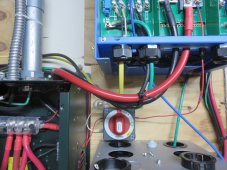This is my "temporary" solution since I'd prefer some kind of push button and not some rotary switch. You can see the bulb next to switch in upper left corner. Since this switch has two position I have it so that first position pre-charges the first Quattro and 2nd position pre-charges 2nd Quattro.
Each red wire connects to a Quattro. They both have fuses near where they connect to the Quattros since that wire will be powered whenever the inverters are on.
The white wire is built-into the bulb socket and connects to a battery busbar (it's red again on the busbar you see since I had to butt splice more wire onto it to reach and used red). It also has a fuse on it since that will be powered whenever busbar is energized.
So there is total of 3 fuses. I've tried it once already and works like Dexter shows on his video.
View attachment 161960



